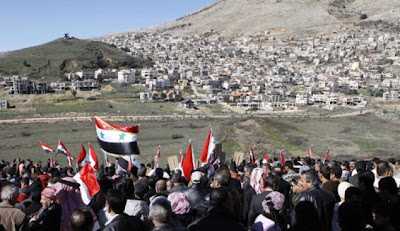By Miri –
Druze Religion
The Druze are a religious community which emerged around the 11th century from Ismailism, the second largest branch of Shia Islam. The main distinguishing factor from other branches of Islam is constituted in the Druze acceptance of the divinity of Hakim, the third Fatimid caliph of Egypt, which also forms the basis of the Druze being considered heretics by many other Muslims. The Druze canon draws on a variety of sources, including Judaism, Greek philosophy and Gnosticism among others.
 |
| The Druze Star, each colour pertains to a metaphysical power |
Since its official revelation in Egypt in 1017, the history of the community has been and continues to be a very turbulent one. Spread out throughout the Middle East and under the rule of different sovereigns, the Druze faced severe persecution which at times almost led to their extinction. At other times the community was very much respected by the respective rulers and even gained considerable political powers.
The experience of persecution, which was mostly, but not exclusively based on religious grounds, led the Druze to the practise of what is referred to as taqiyye,whichallows them to conceal their beliefs and to integrate with differing groups, while at the same time continuing their religious belief in secret. Until today, the Druze are considered to be highly secretive and protective about their believes and practices, including towards members of their own communities, which are therefore divided into the uqqal, “the initated”, a minority within the community which demonstrates extreme piety and devotion, and the juhhal, “the ignorant ones”, who live a rather secular life. Another factor which is said to have contributed to the survival of this exclusive community that does not allow conversions and discourages inter-religious marriage, is the Druze loyalty to the land or country they live in, a notion that is being complicated by the fact that the great majority of today’s one million Druze live around the contested borders of Israel, Lebanon and Syria.
The Druze in Israel/Palestine
There are currently approximately 100,000 Druze living in Israel, the majority of which lives in the North of the country. The Druze are one of the recognised religious minorities of Israel. As opposed to Palestinian citizens of Israel, Druze and also Bedouins are drafted to the Israeli military and have frequently attained high positions in the forces. Among Palestinians, Druze soldiers and border police are notorious for being especially violent and aggressive, a notion that has resulted from a number of different factors, which brings us straight to the discussion of the complexity of Israeli Druze political identity.
The Druze in Mandatory Palestine
 |
| Druze uqqal, wearing religious dress |
As opposed to the Druze communities living in Lebanon and Syria, who played an important role in those countries’ anti-colonial struggles, the Druze living in Mandatory Palestine, most of which were peasants and lacked any organised political institutions, remained largely outside of nationalist Arab political activities.
Before 1948 many Druze viewed the tensions between Zionists and Arabs as a religious conflict between Jews and Muslims, which thus did not concern them. There were however small numbers of Druze who supported Arab nationalists and also an increasing number who supported the Jews. Some Arab militias reacted with scorn to what they saw as betrayal and attacked some of the Druze villages. The key moment of the division between the Druze communities and Arab nationalists was however constituted by the demand of the Islamic Waqf, a trust that controls and manages Muslim edifices, to take take over Jethro’s Tomb, located west of Tiberias and constituting the holiest site to the Druze. This issue stirred outrage and protest among the Druze communities, including those living in Syria and Lebanon and led them to take a united stance and to petition Muslim and Arab leaders, as well as British officials. Eventually, in 1945 a court decided that the site should remain under Druze control.
At the same time the Jewish leadership in Palestine took advantage of the increasing tensions between the Druze and the Arab nationalists and started developing relationships with some of the communities and supported and defended them against assaults. Hence in the war of 1948 a number of Druze joined the Hagannah in their fight against the Palestinians. In return, the Druze villages were spared from attacks of Jewish forces and the communities were not expelled.
The Druze in the State of Israel
At the request of Druze leaders, seeking to gain more political influence and support from the Jewish leadership, but also in order to improve the situation of Israel’s Druze communities, a decision was made in 1956 to subject Druze men to compulsory military service. While it is often claimed that both back then and also now the Druze view conscription as a privilege and willingly join the IDF, it should be noted that many were actually opposed to the decision of 1956 and called for refusal to join the military.
One year later and again at the initiative of the same leaders, the Israeli government designated the Druze as a separate ethnic minority, distinct from other Arabs. Also this move stirred protests as it was seen as another strategy aimed at the “Israelisation” of the Druze and resulting in a further distancing of the latter from other Arabs living in Israel.
 |
| Funeral of a Druze soldier |
Samer Swaid from the Druze Initiative Committee, an organisation that calls for refusal and support of those who refuse to serve in the Israeli army, refers to the policies implemented by the Israeli government as a way “to forcing on them the idea that in the Middle East conflict, the Druze and the Jews share common interests as opposed to Palestinians and Arabs”.
Due to the high importance ascribed to the military within Israeli society, the Druze benefited greatly from conscription in both social and economic terms, as it gave them better access to the labour market, especially, but also beyond the security sector. In addition to that the success stories of many Druze who were promoted to high ranks within the military aparatus, as well as the inclusion of Druze into military rituals, such as parades and other celebrations, “contributed to the deepening of the feeling of belonging to the greater society and the greater Israeli citizenry”. Following Swaid, the number of young Druze men refusing to enlist is growing, a notion that is accompanied by a decrease in the Druze who view themselves as Israeli patriots, according to the “National Strength Survey”.
The Druze of the Occupied Golan
 |
| The Druze village of Majdal Shams in the Golan |
The Syrian Golan Heights, captured by Israel during the 1967 war, have been the home to a large Druze community for a long time. In the course of the war between 80,000 and 131,000 Druze and Circassians fled from the area and only 7000 remained.
From 1967 to 1981, the Golan remained under Israeli military administration. In 1981 the Golan Heights Law was passed, which signified the application of Israeli laws, jurisdiction and administration, which effectively, though not formally, annexed the region to Israel.
The continued conflict between Syria and Israel posed a lot of problems for the Druze on both sides of the border. In 1973 both states therefore agreed to open the Quneitra Crossing and to allow for restricted movement across the border. Civilians are usually allowed to cross for the purposes of university studies and marriage, the latter of which usually signifies a one way journey and the brides are not permitted to return back to their own families.
In the late 1970s, Israel offered all non-Israelis living in the Golan citizenship, but until now more than 90% percent of the Druze reject this offer and remain Syrian nationals, holding only permanent resident status in Israel. The message of the Druze of the Golan is clear, they consider themselves, as well as their land as an inseparable part of Syria.
With the onset of the Syrian uprising in 2011, and especially with President Assad’s excessive use of violence against the Syrian population, many Druze of the Golan have abandoned their feelings of loyalty towards the Syrian government.

Comment (0)